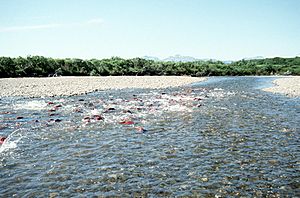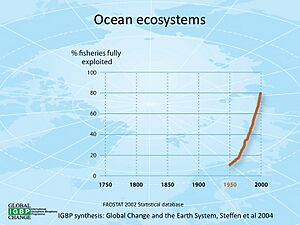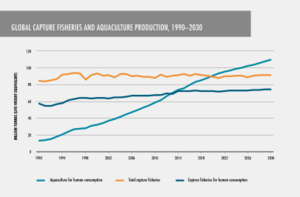Fishery facts for kids
A fishery is a place or an activity where people catch or raise fish and other water animals. It can be a large business or a smaller, local activity. Fisheries include catching wild fish in oceans, lakes, and rivers, and also fish farms where fish are raised. About 90% of all fish caught come from the oceans.
Many people around the world depend on fisheries for their jobs and food. In 2016, about 171 million tonnes of fish were caught or farmed. However, catching too many fish, called overfishing, is a big problem. It can cause the number of fish in the ocean to go down.
Because fisheries are so important, there are rules and laws to manage them. These rules help prevent too many fish from being caught and keep the fishing business healthy. In the past, people just caught fish wherever they wanted. But now, with more people fishing and environmental changes, rules are needed to protect fish and the places they live.
Sometimes, fish populations shrink because of pollution or damage to coastal areas. This can make it harder for people to find food and jobs. Climate change also affects oceans, which can change where fish live and how many there are.
Contents
What is a Fishery?
The FAO says a fishery is any activity where fish are caught. This can be catching wild fish or raising them on a farm. A fishery is usually defined by who is fishing, what kind of fish they are catching, where they are fishing, and how they are doing it.
Sometimes, the word "fishery" also includes the fish themselves and the places they live, like their habitats. This is especially true for groups that focus on fishing for fun, like recreational fishing.
What Does Fish Mean?
The word fish can mean different things:
- In biology – A fish is an animal with gills that lives in water. It usually has fins. Some animals like shellfish or jellyfish are often called "fish," but they are not true fish in biology.
- In fisheries – When talking about fisheries, "fish" is a wider term. It includes not just true fish, but also animals like crabs, shrimp, and oysters that are caught for food or money.
- True fish – To be clear, biologists sometimes use "true fish" or "finfish" to talk about the animals that are actually fish, like salmon or tuna, to tell them apart from other water animals.
Kinds of Fisheries
The fishing industry has three main types:
- Commercial fishing: This is done by businesses to sell fish.
- Recreational fishing: This is fishing for fun or sport.
- Subsistence fishing: This is fishing done by people to feed themselves and their families.
Fisheries can be in saltwater (oceans) or freshwater (lakes and rivers). They can also be wild (catching fish in their natural homes) or farmed (raising fish in special areas). Most of the fish caught in the world, about 85%, are finfish. Popular ones include anchovies, pollock, and tuna.
Examples of fisheries include catching salmon in Alaska, cod near the Lofoten islands, or shrimp farming in China. Most ocean fishing happens near the coast. This is because it's easier to fish in shallower waters, and there's more food for fish near the coast. However, some fishing also happens in the open ocean or in large lakes and rivers.
While most fisheries catch wild fish, fish farming is growing. Fish farms can be in coastal areas, like oyster farms, or inland in ponds and tanks.
Many different kinds of animals are caught in fisheries, including finfish, crabs, lobsters, and oysters. A few species make up most of the world's catch, such as herring, cod, tuna, shrimp, and salmon.
In 2022, small-scale fisheries, which are often run by families or small groups, caught about 40% of the world's fish. They also provide jobs for 90% of the people who catch fish, with women making up 40% of this workforce. About 500 million people rely on these smaller fisheries for their living.
Inland fisheries, which are in lakes and rivers, produced 11.3 million tonnes of fish in 2022. Most of this came from Asia and Africa, where these fisheries are very important for feeding people. India, Bangladesh, and China were the top producers.
Why Fisheries are Important
More than 500 million people in developing countries depend on fisheries and fish farming for their jobs and food. When too many fish are caught, it can reduce the number of fish available and cause people to lose their jobs. In 2014, it was estimated that fisheries added about US$270 billion to the world's economy each year. If fishing were managed more sustainably, this amount could increase by US$50 billion. In 2022, most of the people working in fisheries were in Asia, Africa, and Latin America.
Besides commercial and subsistence fishing, fishing for fun (sport fishing) is also very popular and important for the economy in many places.
How Much Fish is Produced?
In 2016, the total amount of fish produced reached a record high of 171 million tonnes. Most of this fish, about 88%, was eaten directly by people. This was possible because wild fishing stayed steady, less fish was wasted, and fish farming continued to grow. This meant that each person ate about 20.3 kg of fish in 2016, which was also a record. Since 1961, the amount of fish people eat has grown twice as fast as the world's population.
Experts predicted that by 2030, the amount of fish produced, eaten, and traded around the world would continue to increase, but at a slower rate. They also expected that fish farming would continue to grow and help meet the demand for fish.
Managing Fisheries
Managing fisheries means making rules and plans to make sure there are enough fish for the future. This includes setting limits on how many fish can be caught, where and when people can fish, and what kind of gear they can use. The goal is to keep fish populations healthy and ensure that people can continue to fish for a long time.
Global Goals for Fisheries
Countries around the world are working together to protect oceans and support sustainable fishing. One important goal is called Sustainable Development Goal 14, "Life Below Water." This goal focuses on keeping coastal areas healthy and helping communities use their fisheries and fish farms in ways that don't harm the environment.
Environmental Concerns
Fishing can sometimes affect the environment. This includes things like accidentally catching other animals, damaging the seafloor with fishing gear, or creating pollution.
Climate Change Effects
Climate change is also affecting fisheries. As oceans get warmer and more acidic, it can change where fish live and how well they reproduce. Some fish might move to new areas, while others might struggle to survive. This makes it even more important to manage fisheries carefully to protect them from these changes.
See also
 In Spanish: Explotación pesquera para niños
In Spanish: Explotación pesquera para niños
- Fisheries science
- Ocean fisheries
- Population dynamics of fisheries
External links
- FAO Fisheries Department
- The Fishery Resources Monitoring System (FIRMS)





